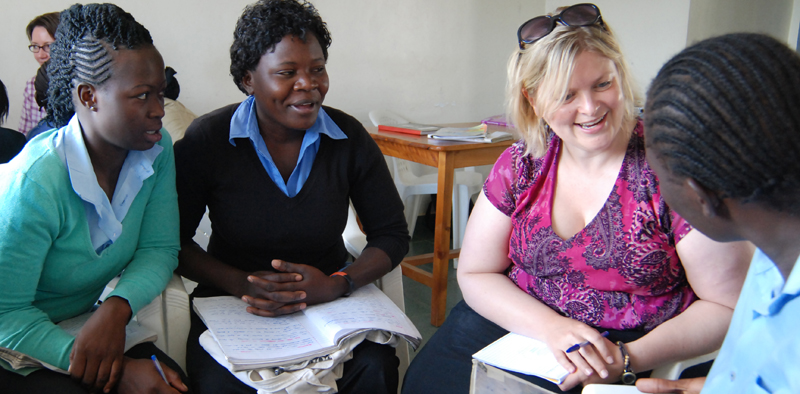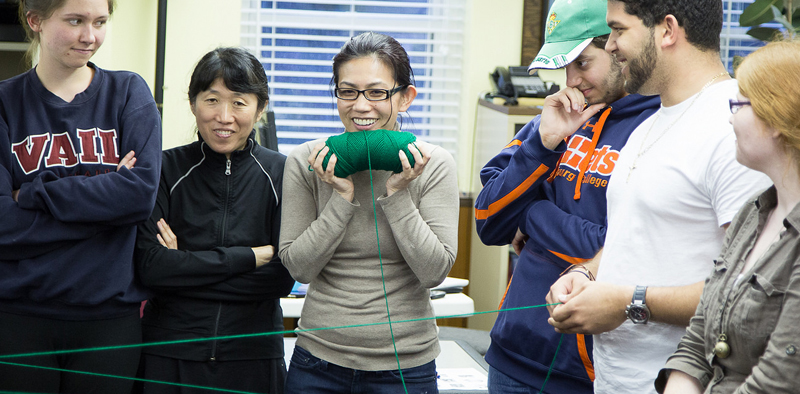- Teach a Community-Engaged Learning course
- Undertake Community-Based Research
- Register a Community-Engaged Learning course
- Become a Community-Engaged Learning Faculty Fellow
- Lead an Immersion Project
Community-Engaged Learning
Community-engaged learning (CEL) is a pedagogical model that connects classroom-based work with meaningful community involvement and exchange. Within the context of equitable partnership, community organizations and students mutually benefit from the CEL experience both by meeting course objectives and addressing community-identified goals.
Students may engage with groups including, but not limited to: nonprofits, government agencies, grassroots collectives, and other educational institutions.
The degree of involvement can vary as can the model of engagement.
The principles of CEL include:
- Faculty, students, and community groups collaborate toward mutually pursuing community-identified goals and academic course objectives.
- Courses provide adequate reading, reflection, and evaluation through research and other coursework; faculty meet their course objectives by preparing students for community entry, providing meaningful outlets for critical reflection, and presenting methods of rigorous evaluation.
- Academic credit is given for classroom and community learning, demonstrated in preparation, research, evaluation, and reflection
How do community agencies benefit?
- Expansion of mission and reach without increasing costs
- Increased public support and visibility in the community as students are ambassadors
- Meet needs and priorities for individuals and communities, as students bring new energy, capacity, and creative ideas.
- Builds relationships and trust between residents and students
- Increases resources, reduction in barriers
How do students benefit?
- Provides students with direct experience with topics they are studying
- Allows for reflection in a classroom setting
- Promotes the complexity of understanding, problem analysis, critical thinking, and cognitive development
- Enables the possibility for cognitive dissonance/disequilibrium to occur in a setting where students can receive support from faculty, peers, and course content
- Resonates with students from a variety of cultural backgrounds
- Encourages personal development such as sense of personal efficacy, personal identity, spiritual growth, communication skills and moral development
- Reducing stereotypes and facilitating cultural and racial understanding
- Increases relationships with faculty, peers and community members
Kuh, George. "High-Impact Educational Practices" Association of American Colleges and Universities., 2008. Web. 04 April. 2013.
Eyler, Janet, Giles Jr., Dwight, Stenson, Christine and Gray, Charlene. “At A Glance: What We Know about The Effects of Service-Learning on College Students, Faculty, Institutions and Communities, 1993-2000: Third Edition” 2001. Vanderbilt University.
Community-Based Research
“Community-based research is research that is conducted by, with, or for communities” (Sclove et al., 1998, p. ii). It is a collaborative form of inquiry in which academic institutions and community members seek to offset the prevalence of traditional academic research by acknowledging the expertise of community members (Hills & Mullett, 2000).
Community members help determine the direction of the research, providing community knowledge and participating in the research process with the intent to solve problems and create change that leads to social justice by “empowering and helping to build capacity among community members” (Strand et al., 2003, p. 14).
Community-based research is “a partnership of students, faculty, and community members who collaboratively engage in research with the purpose of solving a pressing community problem or effecting social change” (Strand et al., 2003, p. 3).
Strand et al. (2003) outlined three guiding principles:
- collaboration,
- validation of the knowledge of community members and the multiple ways of collecting and distributing information, and
- “social action and social change for the purpose of achieving social justice” (p. 8).
From “Reaching for a Radical Community-Based Research Model” by Barri Tinkler, June 19th, 2012. Posted in Posted in Journal for Community Engagement and Scholarship Vol. 3 No. 2.
Community based research strives to be:
Community situated -begins with a research topic of practical relevance to the community (as opposed to individual scholars) and is carried out in community settings.
Collaborative -community members and researchers equitably share control of the research agenda through active and reciprocal involvement in the research design, implementation and dissemination.
Action-oriented -the process and results are useful to community members in making positive social change and to promote social equity.
Essential Aspects of community based research
- The relevance of the research topic is identified or verified by community members.
- The resources of research (financial, expertise, etc.) are shared with community members, particularly those most affected by the research topic.
- The research process recognizes and utilizes the expertise that community members have.
- The research process recognizes and addresses power imbalances between researchers and community members.
- The research process is driven by values, including: empowerment, supportive relationships, social change, learning as an ongoing process and respect for diversity.
- The research process and results are accessible and understandable to community members.
- The research process and results consider and adapt to the context in which the research is conducted.
- The research leaves a legacy, both in terms of the utilization of research results, as well as in the future collaboration among partners.
Taken from What is Community-Based Research?
How is CBR different from traditional research?
There are several distinct differences between Community-Based Research and traditional research. This chart sheds light on these differences (PDF).
Additional Readings:
Undergraduates and Community-Based Research: Benefits, Challenges and Opportunities
Community-Campus Partnerships for Health


